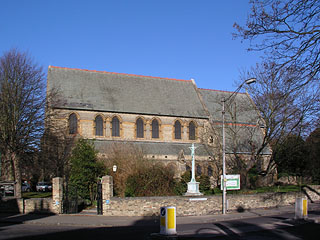St Giles is a church with an unlovely exterior. It sits at the bottom of Castle Hill, looming over the crossroad north of Magdalene Street. It sits a little way up the slope, and hence has a rather imposing position, but this is mostly wasted - the church was entirely rebuilt in 1875, a projected tower was never built, so all that one now sees is a long nave with two aisles and a bleak west end, all built in blackening brick. Indeed, in an earlier version of this page I gave my opinion was that St Giles is probably the most unattractive church in the city. The view from the west has a certain bleak grandeur, I suppose - a mass of brown brick with a buttress in the middle and two mean windows on either side - but only when I'm feeling at my most Larkin-esque do I even come close to liking it. [Mark adds: I disagree (although I'm no huge fan of St Giles it is certainly the case that St Andrew the Great is worse) and I think it can look almost noble when seen from St Peter's across the road, tall and french...at least on a fine sunny December day.]
We received several representations about this judgement and, although St Giles is still far from one of my favourite churches, after several years of trying Mark and I managed to get inside early in 2009, and found it surprisingly nice. It helped that we visited when the church was full of life - various church officials were pottering around preparing for the service on the next day, and an orchestra was rehearsing the William Tell overture with a lot of gusto. The church officials were a bit officious (one man was quite shirty with Mark about his taking photographs) but there was nevertheless a welcoming feel to the place. I wish I'd made it in earlier.
The main mass of the church is a broad nave of four bays. The arcades are simple, with very wide arches, and are topped by a large expanse of sandblasted wall. Clerestory windows sit pairwise in deep frames, and the pairs are divided by little engaged shafts which support the severe barrel-shaped roof. The windows are filled with quite dark glass, but on a bright day the nave was still full of light.
Indeed, the windows are worthy of mention, especially in the aisles. The windows here depict various saints and other luminaries of the Church of England - not just the usual people like St Catherine of Siena, St Augustine, St Edward the Confessor and St George; but also Charles I and Henry VI, the latter looking very androgynous and carrying a little model of the chapel of King's College.
The chancel is guarded by a good rood screen, set up on some steps and most important. Within, the sanctuary has a very French look to it, with a big rose window in the east wall and a couple of tall plain windows.
More excitingly, in the east end of each aisle is a fragment of the older church which was destroyed to build the current structure. In the north aisle sits a heavy thick-set transitional doorway decorated with several layers of zig-zag moulding. It is terribly weathered, but still a nice survival. In the south aisle is an even older survival - the original 11th century chancel arch. It's not as good as the contemporary tower arch at St Benet's in the centre of town, but it is still rather good, and there's something nice about it still being in use after nine centuries. Behind it is a chapel containing some monuments, but it was locked when we visited.
As Mark took his photographs, I drifted up to the west end of the church and looked at a little display of plans from the rebuilding of the church. There was a fine architectural drawing of the west tower which was never built. It would have been quite vast - as tall as the great spire on Our Lady and the English Martyrs, and much more imposing due to its position on Castle Hill. What a pity that they never built it.
St Giles has no information about keyholders, but is now frequently open.

